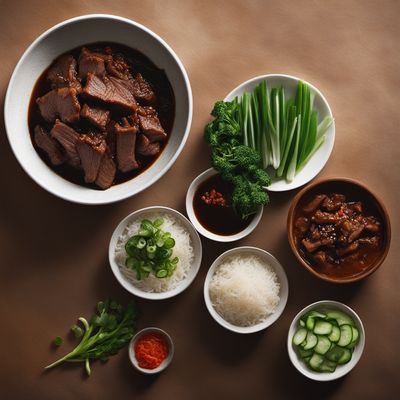
Recipe
Filipino Chinese Casatiello
Savory Fusion: Filipino Chinese Casatiello
4.7 out of 5
Indulge in the delightful fusion of Italian and Filipino Chinese cuisines with this Filipino Chinese Casatiello recipe. This unique dish combines the traditional Italian flavors of Casatiello with the vibrant and bold flavors of Filipino Chinese cuisine.
Metadata
Preparation time
30 minutes
Cooking time
35 minutes
Total time
1 hour 5 minutes
Yields
6 servings
Preparation difficulty
Medium
Suitable for
Omnivore, Dairy-free (if omitting cheese), Nut-free, Shellfish-free, Egg-free (if omitting eggs)
Allergens
Wheat, Soy, Eggs
Not suitable for
Vegan, Vegetarian, Gluten-free, Paleo, Keto
Ingredients
In this Filipino Chinese adaptation of Casatiello, we incorporate traditional Filipino Chinese ingredients and flavors to give the dish a distinct twist. The original Italian Casatiello typically includes ingredients like salami, cheese, and eggs. However, in this Filipino Chinese version, we replace the salami with Chinese sausage (lap cheong) and add ingredients like soy sauce, oyster sauce, and ginger to infuse the dish with the flavors of Filipino Chinese cuisine. We alse have the original recipe for Casatiello, so you can check it out.
-
500g (4 cups) all-purpose flour 500g (4 cups) all-purpose flour
-
10g (2 tsp) instant yeast 10g (2 tsp) instant yeast
-
10g (2 tsp) sugar 10g (2 tsp) sugar
-
10g (2 tsp) salt 10g (2 tsp) salt
-
250ml (1 cup) warm water 250ml (1 cup) warm water
-
2 tbsp vegetable oil 2 tbsp vegetable oil
-
100g (3.5 oz) Chinese sausage (lap cheong), diced 100g (3.5 oz) Chinese sausage (lap cheong), diced
-
1 small onion, finely chopped 1 small onion, finely chopped
-
2 cloves garlic, minced 2 cloves garlic, minced
-
1 small carrot, finely diced 1 small carrot, finely diced
-
1 small bell pepper, finely diced 1 small bell pepper, finely diced
-
2 tbsp soy sauce 2 tbsp soy sauce
-
1 tbsp oyster sauce 1 tbsp oyster sauce
-
1 tsp ginger, grated 1 tsp ginger, grated
-
1/2 cup grated cheddar cheese 1/2 cup grated cheddar cheese
-
2 eggs, beaten 2 eggs, beaten
-
Sesame seeds, for garnish Sesame seeds, for garnish
Nutrition
- Calories (kcal / KJ): 350 kcal / 1465 KJ
- Fat (total, saturated): 12g, 4g
- Carbohydrates (total, sugars): 48g, 3g
- Protein: 12g
- Fiber: 2g
- Salt: 1.5g
Preparation
-
1.In a large mixing bowl, combine the flour, yeast, sugar, and salt. Mix well.
-
2.Gradually add the warm water and vegetable oil to the dry ingredients. Mix until a dough forms.
-
3.Transfer the dough to a floured surface and knead for about 10 minutes, until smooth and elastic.
-
4.Place the dough in a greased bowl, cover with a clean kitchen towel, and let it rise in a warm place for about 1 hour, or until doubled in size.
-
5.In a skillet, heat some oil over medium heat. Add the Chinese sausage, onion, garlic, carrot, and bell pepper. Cook until the vegetables are tender.
-
6.Add the soy sauce, oyster sauce, and grated ginger to the skillet. Stir well to combine.
-
7.Remove the skillet from heat and let the filling cool.
-
8.Preheat the oven to 180°C (350°F).
-
9.Punch down the risen dough and divide it into two equal portions.
-
10.Roll out one portion of the dough into a circle and place it on a greased baking sheet.
-
11.Spread the cooled filling evenly over the dough, leaving a small border around the edges.
-
12.Sprinkle the grated cheddar cheese over the filling.
-
13.Roll out the second portion of the dough into a circle and place it on top of the filling.
-
14.Pinch the edges of the dough together to seal the filling inside.
-
15.Brush the beaten eggs over the top of the dough and sprinkle with sesame seeds.
-
16.Bake in the preheated oven for 30-35 minutes, or until the bread is golden brown and cooked through.
-
17.Remove from the oven and let it cool for a few minutes before slicing.
-
18.Serve warm and enjoy!
Treat your ingredients with care...
- Chinese sausage (lap cheong) — If you can't find Chinese sausage, you can substitute it with regular sausage or bacon for a different flavor profile.
Tips & Tricks
- You can customize the filling by adding other vegetables like mushrooms or bamboo shoots.
- For a spicier version, add some chili flakes or hot sauce to the filling.
- Make sure to let the filling cool before spreading it on the dough to prevent the dough from becoming soggy.
- Serve the Filipino Chinese Casatiello as a main dish or as an appetizer for parties and gatherings.
- This bread is best enjoyed fresh out of the oven, but you can also reheat leftovers in the oven for a few minutes to regain its crispiness.
Serving advice
Serve the Filipino Chinese Casatiello warm, either as a standalone dish or accompanied by a fresh salad or soup.
Presentation advice
To enhance the presentation, sprinkle some chopped green onions or cilantro on top of the bread before serving. This adds a pop of color and freshness to the dish.
More recipes...
For Italian cuisine » Browse all
For Filipino Chinese cuisine » Browse all
More Italian cuisine dishes » Browse all

Mozzarella milanese
Milanese mozzarella
Mozzarella milanese is a classic Italian dish that is made by frying mozzarella cheese.

Papero alla frutta
Duck with Fruit
Papero alla frutta is a traditional Italian dish that consists of roasted duck served with a side of fruit sauce. The dish is typically served...

Canestrelli di Avosso
Canestrelli di Avosso are a type of Italian cookie that are typically made with flour, sugar, and butter. They have a crumbly texture and are...









